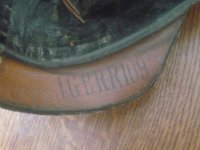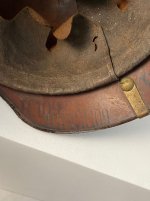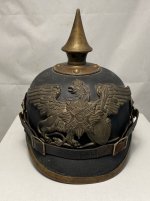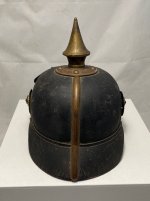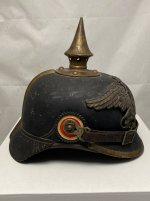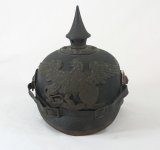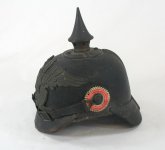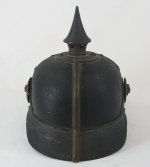This Pickelhaube is a war trophy brought back to England by British Army Veteran. I was immediately attracted to it because it has the field worn and captured look about it. Of course, my first inclination was to clean off the dirt accumulated on it over the years. But my attraction to it was that it genuinely represented something brought back from the battlefield and not from a war bonds drive, occupation purchased helmet or found later in a European flea market.
The rear visor provides a fascinating history; the first stamping outlined in a rectangle: BA VI with 1908 immediately underneath represents Bekleidungs Amt VI, or Clothing Depot, of the (German), VI Army Corps purchased and issued the helmet in 1908; the stamp adjacent to it is R 10 indicating that it was issued to Grenadier Regiment “King Frederick Wilhelm II” (1st Silesian) Nr. 10. The helmet has a removable spike that confirms this helmet for a unit authorized to wear a Trichter or Parade Plume; the 10th wore a black plume. Before a Tommy picked it up, another rectangle stamp with R16 11 2B denotes the helmet was in Regiment 16 or Infantry Regiment “Freiherr von Sparr” (3rd Westphalian) No. 16. The other numbers indicate the helmet was in the 11th Kompanie and the 2D Battalion of the 16th Regiment. This regiment was assigned to the 27th Infantry Brigade, 14th Division in the VII Army Corps. The 16th and its parent units fought against the BEF through most of the war.
Should I clean the outside of my latest purchase or leave it just as is?
I want to show the helmet in its current condition while protecting it from the elements. So, I purchased a basketball trophy case at our local Hobby Lobby store* to keep the dust, dog, and cat hair, as well as the occasional child or adult’s fingers off it. You can see that large portions of the leather shell are visible because the original laquear has come off parts of the Pickelhaube.
Because I am concerned about preserving this battlefield relic for history, I am torn between leaving the helmet or cleaning the dust and dirt off to prevent possible contamination that can lead to detrition. I have considered possibly spraying it with a flat lacquer to prevent further deterioration. However, I believe that is not a good option.
I trust that you have enjoyed the post.
Best regards,
John
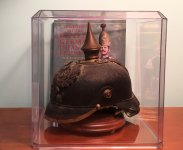
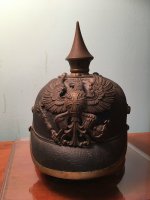
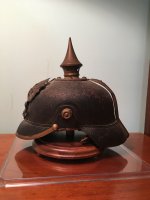
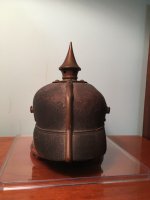
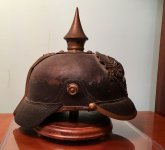
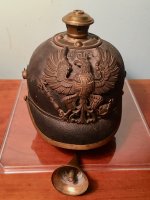

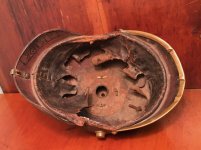
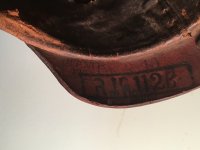
References consulted
Chris Dale’s Traditions of the Imperial German Infantry Regiments: their Histories, Uniforms & Pickelhauben
Joseph Robinson and Maxime Chaffotte’s web page Depot Marks https://pickelhauben.net/depot-marks/
14th Division (German Empire) https://de.zxc.wiki/wiki/14._Division_(Deutsches_Kaiserreich)
* Basketball & Soccer Ball Display Case: Dimensions: Length: 10" Width: 10" Height: 10"
https://www.hobbylobby.com/Home-Decor-Frames/Frames-Photo-Albums/Shadow-Boxes-Display-Cases/Basketball-Soccer-Ball-Display-Case/p/81011632
The rear visor provides a fascinating history; the first stamping outlined in a rectangle: BA VI with 1908 immediately underneath represents Bekleidungs Amt VI, or Clothing Depot, of the (German), VI Army Corps purchased and issued the helmet in 1908; the stamp adjacent to it is R 10 indicating that it was issued to Grenadier Regiment “King Frederick Wilhelm II” (1st Silesian) Nr. 10. The helmet has a removable spike that confirms this helmet for a unit authorized to wear a Trichter or Parade Plume; the 10th wore a black plume. Before a Tommy picked it up, another rectangle stamp with R16 11 2B denotes the helmet was in Regiment 16 or Infantry Regiment “Freiherr von Sparr” (3rd Westphalian) No. 16. The other numbers indicate the helmet was in the 11th Kompanie and the 2D Battalion of the 16th Regiment. This regiment was assigned to the 27th Infantry Brigade, 14th Division in the VII Army Corps. The 16th and its parent units fought against the BEF through most of the war.
Should I clean the outside of my latest purchase or leave it just as is?
I want to show the helmet in its current condition while protecting it from the elements. So, I purchased a basketball trophy case at our local Hobby Lobby store* to keep the dust, dog, and cat hair, as well as the occasional child or adult’s fingers off it. You can see that large portions of the leather shell are visible because the original laquear has come off parts of the Pickelhaube.
Because I am concerned about preserving this battlefield relic for history, I am torn between leaving the helmet or cleaning the dust and dirt off to prevent possible contamination that can lead to detrition. I have considered possibly spraying it with a flat lacquer to prevent further deterioration. However, I believe that is not a good option.
I trust that you have enjoyed the post.
Best regards,
John









References consulted
Chris Dale’s Traditions of the Imperial German Infantry Regiments: their Histories, Uniforms & Pickelhauben
Joseph Robinson and Maxime Chaffotte’s web page Depot Marks https://pickelhauben.net/depot-marks/
14th Division (German Empire) https://de.zxc.wiki/wiki/14._Division_(Deutsches_Kaiserreich)
* Basketball & Soccer Ball Display Case: Dimensions: Length: 10" Width: 10" Height: 10"
https://www.hobbylobby.com/Home-Decor-Frames/Frames-Photo-Albums/Shadow-Boxes-Display-Cases/Basketball-Soccer-Ball-Display-Case/p/81011632

